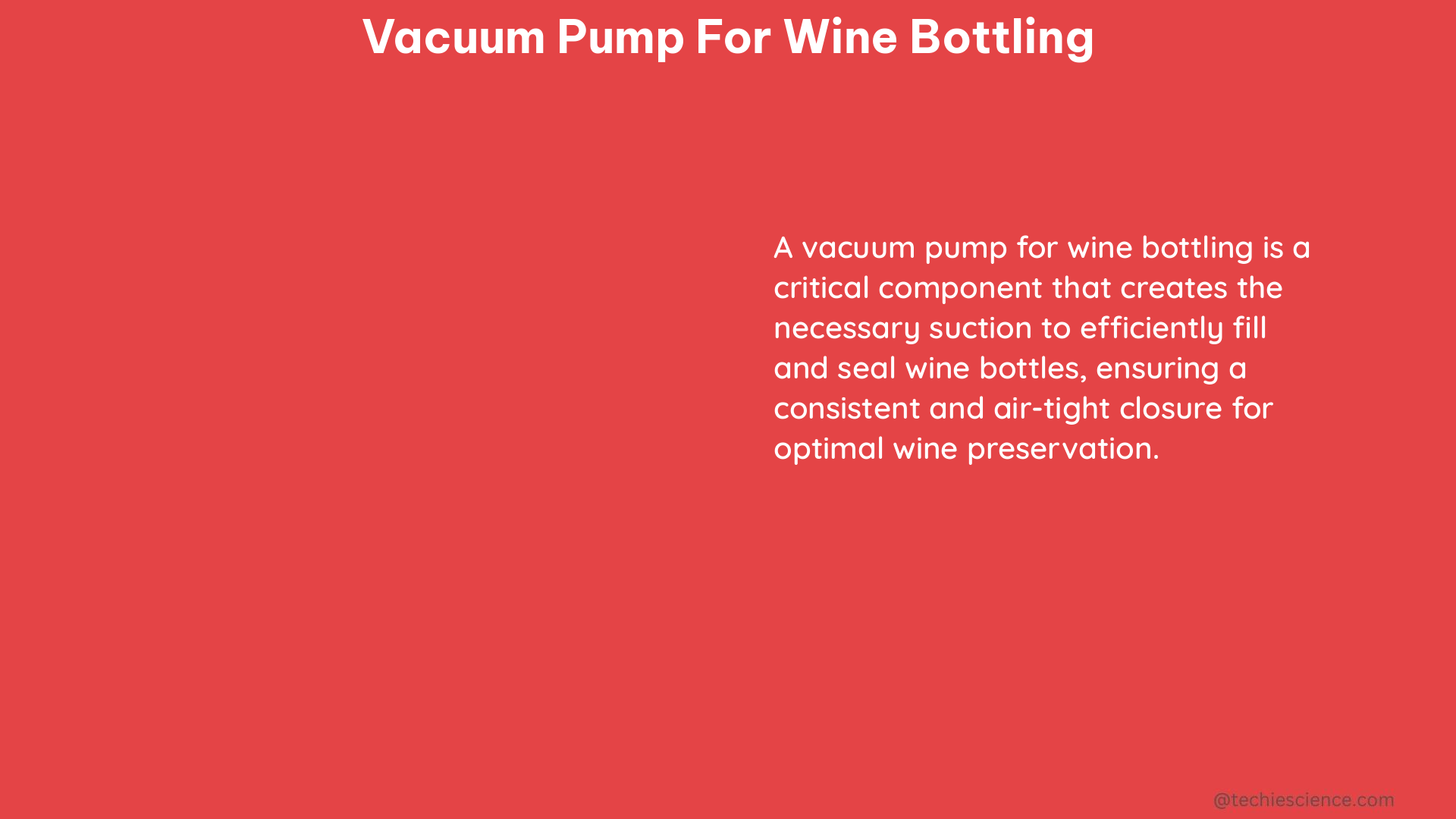Vacuum pumps play a crucial role in the wine bottling process, ensuring the preservation of the wine’s flavor and quality. By removing excess air from the bottles, these pumps create an optimal environment for the wine to age gracefully. This comprehensive guide delves into the technical details and best practices for selecting and using vacuum pumps in wine bottling, empowering you to make informed decisions and achieve exceptional results.
Understanding the Impact of Vacuum Levels on Wine Composition
The level of vacuum drawn during the bottling process can significantly impact the amount of dissolved CO2 and ethanol in the wine. A vacuum level of 27 in Hg (about 0.52 psi absolute) can release more carbon dioxide from the solution, while a vacuum of 2.13 in Hg can cause ethanol to boil and convert to a gaseous state at 19.7°C (67.5°F).
| Vacuum Level | Impact on Wine Composition |
|---|---|
| 27 in Hg (0.52 psi absolute) | Releases more carbon dioxide from the solution |
| 2.13 in Hg | Causes ethanol to boil and convert to a gaseous state at 19.7°C (67.5°F) |
To maintain the desired CO2 level in the wine, it is crucial to use a mix of nitrogen and CO2 gases before priming the line. This gas mixture helps retain the intended CO2 level in the wine. Additionally, the efficiency of the inerting method should be verified by measuring the O2 level in the hoses and the entire circuit, ensuring it has been decreased to less than 2% before pumping the wine into the system.
Managing Headspace Oxygen (HSO) Levels in Bottled Wines

Headspace oxygen (HSO) levels in bottled wines are a critical factor in preserving the wine’s quality and shelf life. Vacuum systems are commonly used before corking to reduce the HSO level. With cylindrical closures, a vacuum system can lower the HSO level to around 8%-10% oxygen. When coupled with inert gas injection, the HSO level can be decreased further, resulting in bottles with as little as 0.2 ppm in the headspace.
However, with screwcaps, the headspace volume is generally larger, and a vacuum system cannot be effectively used. In this case, a generic inerting system can help reduce the average HSO level in screwcapped bottles from 5-6 ppm to 2-3 ppm. For even better HSO management in screwcapped bottles, a system with a double inert gas injection, both inside the screwcap and the bottleneck, is recommended.
Technical Specifications for Vacuum Pumps in Wine Bottling
When selecting a vacuum pump for wine bottling, it is essential to consider the following technical specifications:
- Vacuum Level: The pump should be capable of achieving a high vacuum level, typically in the range of 23.5 to 27 in Hg (0.52 to 0.13 psi absolute).
- Pumping Speed: The pump should have an efficient pumping speed, measured in liters per minute (L/min), to ensure a timely and effective bottling process. For example, the Vacu Vin Wine Saver Pump has a pumping speed of 2.5 L/min.
- Noise Level: A low noise level is desirable, especially in a winery or home setting, to minimize disruption and create a more pleasant working environment.
- Portability and Ease of Use: Compact and user-friendly design can enhance the overall experience and make the vacuum pump more accessible for both professional and home wine enthusiasts.
Factors to Consider When Choosing a Vacuum Pump for Wine Bottling
When selecting a vacuum pump for your wine bottling needs, consider the following factors:
- Intended Use: Determine whether you require a pump for commercial-scale wine production or for home/small-scale winemaking. This will help you choose a pump with the appropriate capacity and features.
- Vacuum Level Requirement: Assess the desired vacuum level based on your wine composition and bottling requirements. Higher vacuum levels may be necessary for certain wine styles or to achieve specific dissolved gas levels.
- Pump Capacity and Efficiency: Evaluate the pump’s pumping speed and its ability to maintain the desired vacuum level throughout the bottling process, especially when handling larger volumes of wine.
- Noise and Vibration: Consider the pump’s noise level and vibration characteristics, as these can impact the overall working environment and user experience.
- Maintenance and Durability: Look for a vacuum pump with a reputation for reliability, easy maintenance, and long-lasting performance to ensure consistent and trouble-free operation.
- Budget and Cost of Ownership: Determine your budget and consider the initial purchase price, as well as the ongoing maintenance and energy costs associated with operating the vacuum pump.
Conclusion
Vacuum pumps are an essential component of the wine bottling process, playing a crucial role in preserving the wine’s flavor and quality. By understanding the impact of vacuum levels on wine composition, managing headspace oxygen levels, and selecting the right technical specifications, you can ensure that your wine bottling operation runs smoothly and produces exceptional results.
Remember to always verify the technical specifications and measurements with the manufacturer or supplier before making a purchase to ensure that the vacuum pump meets your specific requirements and delivers the desired performance.
References:
- Vacuum Levels During Racking and Bottling
- Headspace Oxygen Management in Bottled Wines
- Vacu Vin Wine Saver Pump

The lambdageeks.com Core SME Team is a group of experienced subject matter experts from diverse scientific and technical fields including Physics, Chemistry, Technology,Electronics & Electrical Engineering, Automotive, Mechanical Engineering. Our team collaborates to create high-quality, well-researched articles on a wide range of science and technology topics for the lambdageeks.com website.
All Our Senior SME are having more than 7 Years of experience in the respective fields . They are either Working Industry Professionals or assocaited With different Universities. Refer Our Authors Page to get to know About our Core SMEs.